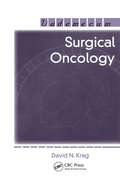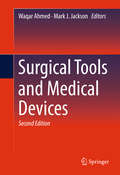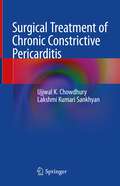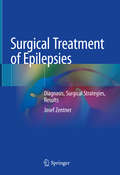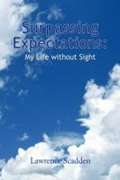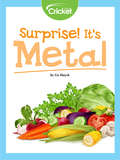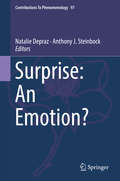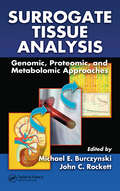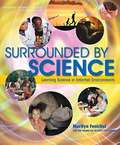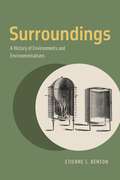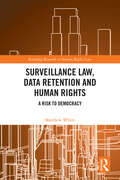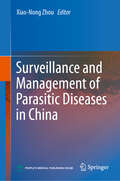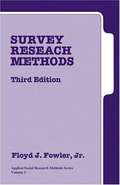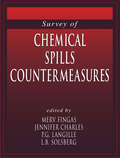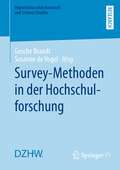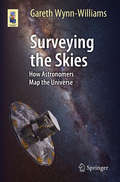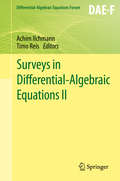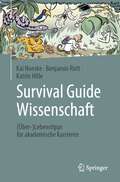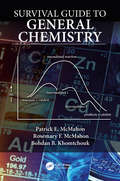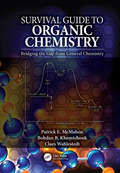- Table View
- List View
Surgical Oncology
by David N. KragThis book meets the information needs of the medical student or surgical resident rotating on a surgical service which emphasizes oncology. It is also useful for the practicing general surgeon in reviewing the most current information on organ specific cancer therapy. It is not designed to be encyclopedic but distills important information about surgical oncology in a concise, up-to-date, and readable manner.
Surgical Strategies in Endourology for Stone Disease
by David M. Albala Sanchia S. Goonewardene Raymond J. Leveillee Karen Ventii Ali GharibThis book provides a practical guide to surgical endourology. Evidence-based chapters give expert opinion on complex cases, best practice techniques, and treating complications. The book covers a broad range of topics required within urological treatment including basic science, imaging in endourology, the use of technological devices, therapeutics for endourology, the treatment of high risk patients, stone disease management, pelvic kidneys, and dialysis. Surgical Strategies in Endourology aims to give the reader guidance in treating patients with endourological conditions and is relevant to both practising and trainee urologists.
Surgical Tools and Medical Devices
by Mark J. Jackson Waqar AhmedThis new edition presents information and knowledge on the field of biomedical devices and surgical tools. The authors look at the interactions between nanotechnology, nanomaterials, design, modeling, and tools for surgical and dental applications, as well as how nanostructured surfaces can be created for the purposes of improving cell adhesion between medical devices and the human body. Each original chapter is revised in this second edition and describes developments in coatings for heart valves, stents, hip and knee joints, cardiovascular devices, orthodontic applications, and regenerative materials such as bone substitutes. There are also 8 new chapters that address:Microvascular anastomosesInhaler devices used for pulmonary delivery of medical aerosolsSurface modification of interference screwsBiomechanics of the mandible (a detailed case study)Safety and medical devicesThe synthesis of nanostructured materialDelivery of anticancer molecules using carbon nanotubesNano and micro coatings for medical devicesThis book is appropriate for engineers, material scientists, chemists, physicists, biologists, medical and dental professionals with an interest in biomedical devices and tools, and researchers in the same fields.
Surgical Treatment of Chronic Constrictive Pericarditis
by Ujjwal K. Chowdhury Lakshmi Kumari SankhyanThis book provides comprehensive information and clarity on all aspects of diagnosing and managing constrictive pericarditis. The operative procedures for constrictive pericarditis are presented in detail with technical tips supplemented by surgical videos. Further, it explores and guides on issues with mixed opinions like the role of corticosteroids, timing of the operation, choice of the operative procedure, terminologies to describe the extent of decortication, and the requirement of cardiopulmonary bypass. Despite experience spanning over 100 years, there is no fool-proof formula in the published literature that can be used in selecting an optimal surgical approach for a given patient. The terms "radical", "total", "extensive", "complete", "subtotal", "adequate", "near-total" and "partial" pericardiectomy also have been variably used in the literature, often without a precise definition of the limits of pericardial resection.Providing an update on the latest advancements and long-term results of pericardiectomy appeals to all clinicians managing constrictive pericarditis. For the trainees, it offers insights into surgical techniques' relevant anatomy and foundation. The book will be beneficial to MBBS, MD, MS, M.Ch (CTVS), DM (Cardiology), Diplomate of National Board (Cardiology and CTVS), FRCS, FRACS, MD (USA, Canada, and in all developing and developed countries).
Surgical Treatment of Epilepsies: Diagnosis, Surgical Strategies, Results
by Josef ZentnerThis book fills the gap between the increasing demand for epilepsy surgical experience and limited training facilities in this area. It comprehensively describes surgical techniques, including tricks and pitfalls, based on the author’s 30 years of experience, providing optimal and effective training for young neurosurgeons by avoiding learning by trial and error. Moreover, it also includes useful information for epileptologists and other professionals involved in the epilepsy surgical program to allow them to gain a better understanding of possibilities and limitations of epilepsy surgery.
Surpassing Expectations: My Life without Sight
by Lawrence ScaddenThe booktells the story of the author's life without sight,a memoir that recalls the activities that brought him international acclaim as a scientist, policymaker, and advocate.
Surprise! It's Metal
by Liz HuyckFrom water, to paint, to breakfast cereal, who could have guessed that all of these things have metal in them? There's metal all around! This story includes a fun experiment to pull iron out of cereal.
Surprise: An Emotion? (Contributions To Phenomenology #97)
by Natalie Depraz Anthony J. SteinbockThis volume offers perspectives on the theme of surprise crossing philosophical, phenomenological, scientific, psycho-physiology, psychiatric, and linguistic boundaries. The main question it examines is whether surprise is an emotion. It uses two main theoretical frameworks to do so: psychology, in which surprise is commonly considered a primary emotion, and philosophy, in which surprise is related to passions as opposed to reason. The book explores whether these views on surprise are satisfying or sufficient. It looks at the extent to which surprise is also a cognitive phenomenon and primitively embedded in language, and the way in which surprise is connected to personhood, the interpersonal, and moral emotions. Many philosophers of different traditions, a number of experimental studies conducted over the last decades, recent works in linguistics, and ancestral wisdom testimonies refer to surprise as a crucial experience of both rupture and openness in bodily and inner life. However, surprise is a theme that has not been dealt with directly and systematically in philosophy, in the sciences, in linguistics, or in spiritual traditions. This volume accomplishes just that.
Surprising Animal Senses (F&P Benchmark Assessment System 1 #Level K, Nonfiction)
by India RubySurprising Animal Senses Author: India Ruby
Surrogate Humanity: Race, Robots, and the Politics of Technological Futures (Perverse Modernities: A Series Edited by Jack Halberstam and Lisa Lowe)
by Kalindi Vora Neda AtanasoskiIn Surrogate Humanity Neda Atanasoski and Kalindi Vora trace the ways in which robots, artificial intelligence, and other technologies serve as surrogates for human workers within a labor system entrenched in racial capitalism and patriarchy. Analyzing myriad technologies, from sex robots and military drones to sharing-economy platforms, Atanasoski and Vora show how liberal structures of antiblackness, settler colonialism, and patriarchy are fundamental to human---machine interactions, as well as the very definition of the human. While these new technologies and engineering projects promise a revolutionary new future, they replicate and reinforce racialized and gendered ideas about devalued work, exploitation, dispossession, and capitalist accumulation. Yet, even as engineers design robots to be more perfect versions of the human—more rational killers, more efficient workers, and tireless companions—the potential exists to develop alternative modes of engineering and technological development in ways that refuse the racial and colonial logics that maintain social hierarchies and inequality.
Surrogate Tissue Analysis: Genomic, Proteomic, and Metabolomic Approaches
by Michael E. Burczynski John C. RockettBoth an introduction and a fundamental reference, this book explores how to apply genomic, proteomic, and metabolomic technologies to surrogate tissue analysis. It reviews fundamental analytical issues and actual initial results generated using these technologies. The book covers transcriptional profiling (genomics), protein profiling (proteomics), methylation profiling (epigenomics), metabolite profiling (metabolomics) and additional biomarker identification methods that can be applied to surrogate tissues. This book is useful to researchers and scientists interested in applying novel methodologies for identifying biomarkers in the fields of pharmacology, toxicology, and medicine.
Surrounded by Science: Learning Science in Informal Environments
by National Research CouncilPractitioners in informal science settings--museums, after-school programs, science and technology centers, media enterprises, libraries, aquariums, zoos, and botanical gardens--are interested in finding out what learning looks like, how to measure it, and what they can do to ensure that people of all ages, from different backgrounds and cultures, have a positive learning experience. Surrounded by Science: Learning Science in Informal Environments, is designed to make that task easier. Based on the National Research Council study, Learning Science in Informal Environments: People, Places, and Pursuits, this book is a tool that provides case studies, illustrative examples, and probing questions for practitioners. In short, this book makes valuable research accessible to those working in informal science: educators, museum professionals, university faculty, youth leaders, media specialists, publishers, broadcast journalists, and many others.
Surrounded by Science: Learning Science in Informal Environments
by National Research Council of the National AcademiesPractitioners in informal science settings--museums, after-school programs, science and technology centers, media enterprises, libraries, aquariums, zoos, and botanical gardens--are interested in finding out what learning looks like, how to measure it, and what they can do to ensure that people of all ages, from different backgrounds and cultures, have a positive learning experience. Surrounded by Science: Learning Science in Informal Environments, is designed to make that task easier. Based on the National Research Council study, Learning Science in Informal Environments: People, Places, and Pursuits, this book is a tool that provides case studies, illustrative examples, and probing questions for practitioners. In short, this book makes valuable research accessible to those working in informal science: educators, museum professionals, university faculty, youth leaders, media specialists, publishers, broadcast journalists, and many others.
Surroundings: A History of Environments and Environmentalisms
by Etienne S. BensonGiven the ubiquity of environmental rhetoric in the modern world, it’s easy to think that the meaning of the terms environment and environmentalism are and always have been self-evident. But in Surroundings, we learn that the environmental past is much more complex than it seems at first glance. In this wide-ranging history of the concept, Etienne S. Benson uncovers the diversity of forms that environmentalism has taken over the last two centuries and opens our eyes to the promising new varieties of environmentalism that are emerging today. Through a series of richly contextualized case studies, Benson shows us how and why particular groups of people—from naturalists in Napoleonic France in the 1790s to global climate change activists today—adopted the concept of environment and adapted it to their specific needs and challenges. Bold and deeply researched, Surroundings challenges much of what we think we know about what an environment is, why we should care about it, and how we can protect it.
Surveillance Law, Data Retention and Human Rights: A Risk to Democracy (Routledge Research in Human Rights Law)
by Matthew WhiteThis book analyses the compatibility of data retention in the UK with the European Convention on Human Rights (ECHR). The increase in the use of modern technology has led to an explosion of generated data and, with that, a greater interest from law enforcement and intelligence agencies. In the early 2000s, data retention laws were introduced into the UK, and across the European Union (EU). This was met by domestic challenges before national courts, until a seminal ruling by the Court of Justice in the European Union (CJEU) ruled that indiscriminate data retention was incompatible with EU law. Since then, however, the CJEU has revised its position and made certain concessions, particularly under the guise of national security. This book focuses on data retention in the UK with the principal aim of examining compatibility with the ECHR. This is explored through a variety of ways including providing an account of democracy and why secret surveillance poses a threat to it, a history of data retention, assessing the seriousness that data retention poses to fundamental rights, the collection of rights that are affected by data retention which are crucial for a functioning democracy, the implications of who can be obligated to retain (and what to retain), the idea that data retention is a form of surveillance and ultimately, with all things considered, whether this is compatible with the ECHR. The work will be an invaluable resource for students, academics, researchers and policy-makers working in the areas of privacy, human rights law and surveillance.
Surveillance and Management of Parasitic Diseases in China
by Xiao-Nong ZhouThis book intends to share the lessons and experiences learnt from the Chinese parasitic diseases control programme to the professionals, policy makers and researchers from other disease endemic countries. Especially, those lessons on surveillance and response have been well distilled at national level in China, where some of parasitic diseases have been and going to be eliminated, e.g. lymphatic filariasis, malaria, schistosomiasis. The book covers the concept and technologies on surveillance and response to endemic and outbreaks of parasitic diseases, as well as relevant case management and data handling. The book includes three main parts. The first part consists of general chapters, which covers the general information on parasitic disease surveillance, the classification and application of surveillance technologies, etc. The second part of chapters cover surveillance technologies on parasites distribution, infections patterns in a region, related vectors, ecological environment elements, and the early warning and response, etc. In the third part of chapters, the concepts, methods, operating procedures, data collection, result analysis, reports and conclusions of various surveillance technologies in detail, along with the examples and guidelines of surveillance and management for parasitic infections are included. The book is likely to be of interest to the world-wide professionals, practitioners, managers and policy makers in governments or industry in the field of infectious diseases control.
Survey Research Methods
by Floyd J. Fowler Jr.Popular with those who want to collect, analyze, or read about survey data this book provides a sound basis for evaluating how each aspect of a survey can affect its precision, accuracy and credibility. Coverage includes: Improved techniques for evaluating survey questions, the latest options available to researchers in using the computer and the Internet for surveys, recent methodological findings to enhance survey research.
Survey of Chemical Spill Countermeasures
by Merv Fingas Jennifer Charles P. G. Langille L. B. SolsbergUntil now, information regarding chemical spill clean-up was available only through manufacturer's literature from an individual firm, or scattered in the traditional textbooks on remediation engineering and hazardous waste management. Survey of Chemical Spill Countermeasures provides a one-stop source of information on how to clean up spill sites in safe, acceptable ways. Because of the ever-growing need to maintain constant vigilance over hazardous chemicals and potential leaks and spills, this reference will become an important source for the practicing environmental engineer and field technician.Survey of Chemical Spill Countermeasures provides operators with useful information on how to clean up sites, including controlling leakage, containment of spills on land and water, and ways to safely transfer and store the contaminants. Additionally, the book includes up-to-date information on containment and treatment technologies, from dredging and vacuuming, to solid and vapor treatment systems.
Survey-Methoden in der Hochschulforschung (Higher Education Research and Science Studies)
by Gesche Brandt Susanne De VogelViele (Erhebungs-)Projekte in der Hochschulforschung bringen neue Erkenntnisse aus dem Bereich der Survey Methodology hervor. Damit Forschende von dieser Expertise profitieren und sie für die Optimierung ihrer Befragungspraxis nutzen können, werden die Ergebnisse in diesem Sammelband zusammengebracht. Vorgestellt werden Beiträge zum Thema Rekrutierung und Incentivierung, Survey Design und Mixed Devices, Instrumentenentwicklung, Panel Attrition und Non-Response sowie internationale Befragungen. Der Fokus liegt dabei auf den besonderen Herausforderungen, die die Erforschung Hochqualifizierter für die Durchführung quantitativer Studien mit sich bringt.
Surveying the Skies
by Gareth Wynn-WilliamsSince the time of Galileo, astronomy has been driven by technological innovation. With each major advance has come the opportunity and enthusiasm to survey the sky in a way that was not possible before. It is these surveys of discovery that are the subject of this book. In the first few chapters the author discusses what astronomers learned from visible-light surveys, first with the naked eye, then using telescopes in the seventeenth century, and photography in the nineteenth century. He then moves to the second half of the twentieth century when the skies started to be swept by radio, infrared, ultraviolet, x-ray and gamma ray telescopes, many of which had to be flown in satellites above the Earth's atmosphere. These surveys led to the discovery of pulsars, quasars, molecular clouds, protostars, bursters, and black holes. He then returns to Earth to describe several currently active large-scale projects that methodically collect images, photometry and spectra that are then stored in vast publicly-accessible databases. Dr. Wynn-Williams also describes several recent "microsurveys" - detailed studies of small patches of sky that have led to major advances in our understanding of cosmology and exoplanets.
Surveys in Differential-Algebraic Equations I
by Achim Ilchmann Timo ReisThe need for a rigorous mathematical theory for Differential-Algebraic Equations (DAEs) has its roots in the widespread applications of controlled dynamical systems, especially in mechanical and electrical engineering. Due to the strong relation to (ordinary) differential equations, the literature for DAEs mainly started out from introductory textbooks. As such, the present monograph is new in the sense that it comprises survey articles on various fields of DAEs, providing reviews, presentations of the current state of research and new concepts in - Controllability for linear DAEs - Port-Hamiltonian differential-algebraic systems - Robustness of DAEs - Solution concepts for DAEs - DAEs in circuit modeling. The results in the individual chapters are presented in an accessible style, making this book suitable not only for active researchers but also for graduate students (with a good knowledge of the basic principles of DAEs) for self-study.
Survival Guide Wissenschaft: (Über-)Lebenstipps für akademische Karrieren
by Benjamin Rott Katrin Hille Kai NoeskeSurvival Guide Wissenschaft – der unverzichtbare Begleiter für angehende Wissenschaftler:innen! Wertvolle Ratschläge, bewährte Strategien und Insiderwissen aus vielen Jahrzehnten akademischer Laufbahnen mit Kurven, Ecken und Kanten. Tipps und Tricks, Dos and Don’ts, um wissenschaftliche Karrieren an Universitäten und anderen Forschungseinrichtungen zu starten, zu überleben und erfolgreich voranzutreiben. Von der Forschungsplanung bis zur Bewerbung um Stipendien und Stellen, von der Netzwerkbildung bis zur Work-Life-Balance, aber auch Exit-Strategien – dieser Survival Guide liefert die entscheidenden (Über-)Lebenstipps für ein Leben in Academia.
Survival Guide to General Chemistry: Bridging The Gap From General Chemistry
by Patrick E. McMahon Rosemary McMahon Bohdan KhomtchoukThis work evolved over thirty combined years of teaching general chemistry to a variety of student demographics. The focus is not to recap or review the theoretical concepts well described in the available texts.Instead, the topics and descriptions in this book make available specific, detailed step-by-step methods and procedures for solving the major types of problems in general chemistry. Explanations, instructional process sequences, solved examples and completely solved practice problems are greatly expanded, containing significantly more detail than can usually be devoted to in a comprehensive text. Many chapters also provide alternative viewpoints as an aid to understanding. Key Features: The authors have included every major topic in the first semester of general chemistry and most major topics from the second semester. Each is written in a specific and detailed step-by-step process for problem solving, whether mathematical or conceptual Each topic has greatly expanded examples and solved practice problems containing significantly more detail than found in comprehensive texts Includes a chapter designed to eliminate confusion concerning acid/base reactions which often persists through working with acid/base equilibrium Many chapters provide alternative viewpoints as an aid to understanding This book addresses a very real need for a large number of incoming freshman in STEM fields
Survival Guide to Organic Chemistry: Bridging the Gap from General Chemistry
by Bohdan B. Khomtchouk Claes Wahlestedt Patrick E. McMahonThe Survival Guide to Organic Chemistry: Bridging the Gap from General Chemistry enables organic chemistry students to bridge the gap between general chemistry and organic chemistry. It makes sense of the myriad of in-depth concepts of organic chemistry, without overwhelming them in the necessary detail often given in a complete organic chemistry text. Here, the topics covered span the entire standard organic chemistry curriculum. The authors describe subjects which require further explanation, offer alternate viewpoints for understanding and provide hands-on practical problems and solutions to help master the material. This text ultimately allows students to apply key ideas from their general chemistry curriculum to key concepts in organic chemistry.
